EDITORS NOTE: Normally for the section “Scandinavian American Spotlight”, the TDT focuses on at least somewhat notable or famous Americans of Scandinavian descent. What follows here though are some brief life stories of just regular Norwegian emigrants who just happen to have the dubious distinction of booking passage on the same boat at the same time. It would be a good guess that, to the end of their days, they probably did not like their adult beverages “on the rocks”.
When the legendary Titanic set sail from Queenstown, Ireland, her last port of call, on 11 April 1912, there were 31 passengers of Norwegian origin on board.
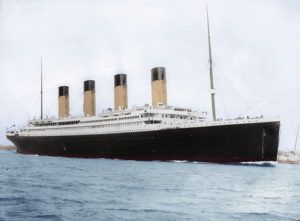
Background
27 of the Norwegian Titanic passengers followed the traveling pattern of most of the more than 700 000 Norwegians who emigrated to America: crossed the North Sea before boarding the actual steamer taking them to America. In 1912, there were several shipping lines between Norway and England. These were mainly operated by the Wilson Line of Hull in England, Fred Olsen’s company of Christiania, The Bergen Steamship Company (BDS) of Bergen and the Nordenfjeldske Steamship Company (NFDS) of Trondheim.
The North Sea run was an ancient trading link, but the British were the first to start a steamship line. Shipowner Thomas Wilson was very enthusiastic about Scandinavia, so in 1840 he was granted the concession to start a permanent shipping line between Gothenburg, Sweden and Hull, England via Christiansand in southern Norway. In 1852, the activity in Norway was expanded with a line between Christiania and Hull, also via Christiansand. By that time, he was getting some minor competition from Norwegian steamship companies, but in the long run, no one could beat the well-financed Wilson. Norwegian companies were literally scared off competing with the British company, so between 1867 and 1881, the Wilson Line was as good as alone on the steamship lines between Norway and Britain. In 1867, Wilson started a mail line between Bergen and Hull, calling at Stavanger.
In 1881, the Norwegian shipowner P. G. Haldorsen finally managed to start a lasting steamship line between Newcastle and Bergen, mainly for coal freight. Haldorsen also saw possibilities in passengers, especially emigrants, so several of his ships were fitted out with passenger accommodation. Nine years later, in 1890, the Norwegian Parliament agreed to support BDS, NFDS and P. G. Haldorsen’s plans to co-operate on a regular mail and passenger line between western Norway and Newcastle. However, two years later Haldorsen had to withdraw due to financial problems, but BDS and NFDS continued the partnership.
The Wilson Line’s route from Christiania was also experiencing more serious competition before the turn of the century. In 1881, the new shipping company of Østlandske Lloyd opened a regular passenger route between Newcastle and Christiania. The growing passenger numbers as a result of the vast emigration inspired shipowner Fred Olsen to establish the joint-stock company of Ganger Rolf in 1899. He soon took over a smaller Norwegian shipping company that operated lines to Scotland and bought Østlandske Lloyd in 1904. Fred Olsen was therefore Wilson’s only serious competitor between Christiania and Britain.
Norway imported nearly all her coal from Britain, so a coal strike there in February 1912 would eventually cause great problems for Norwegian shipping. The situation was not so critical the first few weeks, but by the end of March, the lack of coal was very noticeable. NFDS and BDS, which operated many busy domestic and international routes, were forced to cancel several important sailings, which was very frustrating for the public of course. Usually up to six steamers were used on their joint line to England, but by early April only the Sirius and the Irma could be used. These two steamers were put on the route between Bergen and Newcastle, so for the time being, NFDS and BDS’s line from Trondheim to Newcastle had to be suspended.
Carl Olsen and his nine-year-old son, Arthur, who were going from Trondheim to Arthur’s stepmother in Brooklyn, NY, were traveling with a family friend, Fridtjof Madsen. They began the journey from Trondheim on the BDS’s Capella on 1st April, and arrived in Bergen in the morning two days later. In Bergen, they boarded the BDS’s Sirius, which would take them across the North Sea. In Trondheim, they had booked for the American Line’s Philadelphia from Southampton on 6th April, but because of the coal strike, they were all transferred to the Titanic’s departure on 10th April. The Titanic’s owners, the White Star Line, co-operated with the American Line.
The Sirius was berthed at the Festningskai in Bergen on 3rd April. Among the few spectators on the quay on that wet Wednesday evening, was Sina Olsen. She had left her mother in charge of her two young daughters, while she herself followed her husband Henry down to the harbour. Henry was joining a Norwegian steamer in New York as junior engineer. At 10 pm, the Sirius set sail, and Sina waved as long as the steamer was visible through the fog and drizzling rain. Among the Sirius’s passengers, were also Henry’s new colleagues, second engineer Albert Andersen and second officer Johan Holten. The three sailors were all at first booked on the American Line’s Philadelphia from Southampton on 6th April, but as mentioned, that departure was canceled. Instead, they were transferred to the Titanic’s sailing on 10th April. At four o’clock, early next morning, the Sirius called at Haugesund, and received Bernt Johannessen, Ingvald Hagland, Konrad Hagland, Lena Solvang, Johannes Kalvik and Ole Olson. Ole Olson had been visiting relatives in Etne, north of Haugesund, and was now returning to his farm in Broderick, Saskatchewan. A few hours later, the Sirius arrived in Stavanger, and Daniel Grønnestad embarked. He was supposed to return to America with his brother, who had a ticket booked for the Titanic, but days before departing, he decided to stay a little longer in Norway. The two brothers lived in Portland, North Dakota and had been visiting relatives. At noon, on Saturday 6th April, the Sirius docked at the BDS and NFDS’s wharf in the River Tyne in Newcastle.
Sigurd Moen, Olaus Abelseth, Karen Abelseth, Anna Salkjelsvik, Peter Søholt and Adolf Humblen started their journey from Ålesund at 2 pm on 5th April on board the NFDS’s Erling Jarl, and arrived at the Festningskai in Bergen the following morning. A few hours later, these six Titanic passengers boarded the BDS’s Irma, which was berthed at the same quay. First officer Albert Moss, second officer Knud Rommetvedt and seaman Hans Birkeland were also among the Irma’s passengers. Their employer had hoped to send them to their steamer in Philadelphia on a collier, but the coal strike forced them to abandon that plan. The Irma departed at 2 pm, and sailed out of the harbour under a low cloud base. She continued through the Krossfjord, from where she entered the North Sea. Two days later, on 8th April, the Irma arrived in Newcastle.
The coal strike was also a great burden for the Wilson Line. Many of its world-wide connections were interrupted, including the line between Trondheim and Hull. However, the traffic from Christiania could continue as scheduled. On Wednesday 27th March, the Wilson Line’s Salmo steamed out the Christianiafjord with Johannes Nysveen among the passengers. Initially, he was going by train from Hull to Liverpool, from where the journey would continue on the White Star Line’s Megantic to Boston on 30th March. But like all other White Star liners from that particular port, the sailing was canceled because of the annoying coal strike. Johannes didn’t get a passage on the Olympic from Southampton on 3rd April either, so the only alternative was to wait for the Titanic’s maiden voyage the following Wednesday. One week after the Salmo, the Wilson Line’s Oslo headed for Hull. She set sail from Christiania in the early afternoon of 3rd April. Among the passengers, were Arne Fahlstrøm, who traveled first class on this voyage, Thor Olsvigen and Karl Midtsjø. Arne Fahlstrøm, son of a famous theatre couple in Christiania, was going to America to study theatre and motion picture. He traveled second class on the Titanic. At 10 pm, on Good Friday 5th April, Olaf Pedersen began his journey from Larvik on board the Fred Olsen’s Sovereign, arriving at Tyne Dock in Newcastle two days later.
Upon arriving in England, most of the passengers went straight to Southampton by train, and were lodged at hotels especially for emigrants. The remaining days before boarding allowed plenty of time to write a few words of greeting to family and friends at home, or just wander around busy Southampton. In the late morning of 10 April, 27 Norwegians boarded the Titanic. Two of them, Karl Dahl and Simon Sæther, had come by steamer from Australia and South-Africa respectively. As the Titanic called at Cherbourg later that day, first-class passengers Engelhart Østby and his daughter Helene came on board. Engelhart was born in Christiania, Norway, but had emigrated to Providence, Rhode Island, where he established a world-famous jewelry factory. Five days later, in the early hours of 15 April, the Titanic sank. 1 500 people lost their lives, including 21 of the Norwegians. 10 women in Norway were left widows and 15 children lost their father.
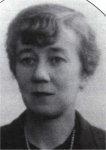
Helen Ragnhild Ostby was born November 30, 1889 in Providence, Rhode Island, to Engelhart Cornelius Ostby and Lizzie Macy Webster. After her mother’s death in 1899, Helen was raised by her father and paternal grandmother. In April 1912, the twenty-two-year-old Helen Ostby and her father were in Europe on one of her father’s business trips. They decided to book first-class passage from Cherbourg, France to New York aboard RMS Titanic with two acquaintances they had met in Egypt, Frank and Anna Warren. The evening of April 14, Helen was in bed when she felt the ship scrape against something, then noticed that the engines had stopped. She recalled that there was no panic, and as the stewards began to assist people into life jackets it seemed that they were doing so only as a precaution. The Ostbys and Warrens stayed together, but Engelhart Ostby returned to the cabin for warmer clothes. Helen never saw him again. His body was found by MacKay Bennett and buried in May 1912 in Providence. Helen Ostby and Anna Warren were rescued by the east-bound Cunarder Carpathia early in the morning of April 15. On the Carpathia, they met two of Helen’s friends from Providence, Howard and Hope Chapin, who were on their honeymoon. Helen and Anna stayed in their cabin as Carpathia during the trip to New York. After the tragedy, Helen Ostby returned to Providence and, with her brother Harold and one of his daughters, managed the family jewelry business. Like her father, she was a frequent traveler to Europe and was in Germany when World War I began. She escaped to the United States but returned to Europe in 1930. She lived in Brussels, Belgium for the next ten years. With the outbreak of war Helene remained in Belgium. In May 1940, she was awakened by bombs falling from German planes. The British and French troops withdrew and for five months Helene again shared a city with a German army of occupation. Eventually she fled to Lisbon where she remained for three months awaiting a plane for America, she arrived in Providence in January 1941. She never returned to Europe. January 1941 she returned to Providence in response to the beginning of World War II. She lived in Providence for the rest of her life and volunteered at Rhode Island Hospital. She never married. She died on May 15, 1978 at the age of 88
Artur Karl Olsen, 9, was born 6 February 1903 on Henry Street, Brooklyn, New York of Norwegian parents Karl Siegwart Andreas Olsen and Ragna Nilsen. After his mother’s death in 1906, his father, Karl Olsen, took him to Trondheim, Norway to live with the boy’s grandmother, Anna Andersen.
Carl Siegwart returned to America where he remarried to Ester (Esther), who was of Swedish origin. They lived on 400 Suydam Avenue, Ridgewood, Central Brooklyn ( 987 Hart St., Brooklyn, New York). Artur’s grandmother died in 1911 so Carl Siegwart traveled back to Trondheim to take Artur back with him to New York. He and his son were originally booked on the Philadelphia but they were transferred to Titanic which they boarded at Southampton as third class passengers. Father and son probably shared a cabin with Fridtjof Madsen with whom they had travelled from Trondheim via Newcastle.
After the collision Karl Siegwart carried his almost sleeping son to lifeboat 13 and said to him that he should be a good boy, and that he would soon come back to him, however Karl was lost in the sinking. Fridtjof Madsen was standing nearby and probably also entered the boat at this time. He was said to have been rescued from the water but boat 13 did not pick up anyone from the water.
In New York, Artur’s stepmother did not know that her husband and stepson had been on board the Titanic. He was met in New York by Mrs William K. Vanderbilt, and she drove him to “Lis a day nursery” on Manhattan Island. On 19 April he met his stepmother for the first time, and she brought him home to her house on Suydam Avenue. Relief funds raised after the tragedy helped to pay his “school money”.
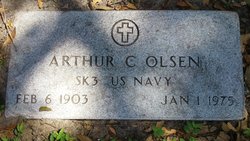
Ester later remarried to William Reichart and together they had a daughter Alvira who was born in 1916. Artur then lived together with them on 911 Avenue P, Brooklyn. For a while, Artur was in the navy, and in later life he held a succession of different jobs, finally settling as a house painter in St. Petersburg, Florida. His last years were spent living at 701 Avenue North.
Artur anglicized his name to Arthur Carl Olsen. He had a brief, unhappy marriage, from which there were no children. He died 1 January 1975 leaving no immediate relatives. He was buried from Northeast Chapel at Royal Palms Cemetery, St. Petersburg, Florida.
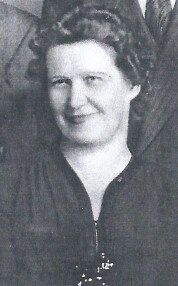
Karen Marie “Katie” Abelseth was born in Alesund, Norway to Kristian and Nikoline (Tosse) Abelseth. Her siblings were: Anna Marie, Anna Louise, Nels Petter, Lisa Olivia, Laurits and Bertha Karoline. The family home was in Sjoholt, Norway. (Her Norwegian name was “Karn”, her spouse called her “Kalla” and others “Katie”. Her grandchildren called her “Nama”)
Karen’s mother died when she was about twelve years old. When she was sixteen years old, it was decided that she would travel to America to live with her older sister, Anna, in Los Angeles. On April 10, 1912, Karen boarded a ship called the Titanic in Southhampton, England. She traveled as third class passenger with Olaus Abelseth (not related), Peter Soholt, Sigurd Moen, Anna Salkjelsvik, and Adolf Humblen from Norway. Olaus, a family friend, promised Karen’s father that he would take care of her on the trip. Only Karen, Olaus and Anna were saved from the sinking. She was put on lifeboat 16, the last to leave on the port side. They were rescued by the Ship Carpathia which sailed for New York arriving on April 18th. Karen spent some time at St. Vincent’s Hospital recuperating before beginning her new life in America. She then traveled by train to Los Angeles with a Swedish family who were also survivors.
Karen is mentioned in Walter Lord’s book “A Night to Remember”. She did attend a luncheon, sitting with the producer of the movie (1958), William MacQuitty at the premiere.
It was 50 years after her death when her daughter Wanda and family learned that Karen had written a letter to her father while at St. Vincent’s about the tragic event. Written in her native language it was translated for them.
Karen and Harry lived for a time in Goldfield, Nevada where their first child, Phyllis, was born. They also lived in Yerington, Nevada for sometime before moving to Inglewood, California.
Karen married Harry Sylvester Little. They had five children: Phyllis Kalla, Norman Harry, Francis Clarence, Wanda Mae and Iris Ellen. In her later years, Karen suffered from the effects of Parkinson’s disease. She passed away on July 27, 1969 in Inglewood. She rests in Inglewood Park Cemetery.
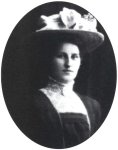
Anna Kristine Salkjelsvik was born in Skodje, Norway, to Ole Iver Johansen Grodas and Anna Marie Salkjelsvik.
On April 12, 1912, she sailed aboard the Titanic as a third class passenger. Her destination was Proctor, Minnesota, where he sister, Olivia, lived. She shared a cabin with some Swedish girls and a Norwegian, Karen Abelseth. Anna left the sinking ship in the collapsible C lifeboat and was reunited with Karen aboard the Carpathia.
On 7 September 1912, she married William Larsen, a fellow Norwegian, in Midway, St. Louis, Minnesota. Four children were born to this union: Margaret (Nelson)1813-1994, Ernest 1918, Astor 1915-1991, and Vivian Janet (Sandeno)(Olafson)1919-1999. Anna, a widower, spent her last years in the Chris Jensen Nursing Home in Duluth, St. Louis, Minnesota, where she died at the age of 86.
Karl Albert Midtsjø was born in Kråkstad municipality (now Nordre Follo municipality ) on Vestre Midtsjø farm and was the son of Johannes and Marie Hansen. He married Anna Christine Paulson (1888-1959) on September 15, 1913 and together they had one son.
Karl Albert bought a ticket on March 30, 1912 that covered his journey all the way from Kristiania to Chicago, Illinois which was his final destination for the trip. It cost 238 kroner, and was bought from general agent Ferdinand J. Elster in Kristiania. He first traveled from Kristiania to Hull , and from there on to Southampton where he boarded the Titanic. On the ship, Karl Albert became well acquainted with another Norwegian named Johannes Nysveen (1851-1912) who, like Karl, traveled alone. It is possible that the two were roommates, but this is uncertain.
During the chaotic hours during the shipwreck, both Karl Albert and Johannes managed to get up on deck to look for lifeboats. On the starboard side of the ship, lifeboat 15 was the penultimate lifeboat that was launched around 01:40, and this had already been halfway through when Karl Albert and Johannes reached it. First mate Murdoch asked for passengers on the ship’s deck who had rowing experience, and with his good physique and experience from Midsjøvannet in Kråkstad, Karl Albert volunteered. Murdoch then gave him permission to climb down the ropes towards the lifeboat. Johannes Nysveen realized that his chances of survival were small, and gave his coat and a pocket watch to Karl Albert. He was asked to hand over these things to Nysveen’s family in North Dakota. Karl Albert agreed to this, climbed down the ropes and survived the shipwreck as a rower in a lifeboat 15.
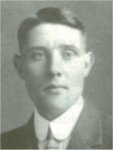
After the accident, Karl Albert was accommodated at St. Vincent’s Hospital, where he stayed for a few days before traveling on to Chicago on April 26. He was here for only a few days before traveling to Cummings, North Dakota to meet Johannes Nysveen’s family and hand over the belongings he had received from him during the shipwreck. Karl Albert’s life after the shipwreck was not marked by drama. He and his family first moved to Evanston, Illinois where he worked as a caretaker, and in 1921 the family moved back to Norway where they lived for barely a year. Later they moved to Maywood, Illinois, and around 1930, Karl Albert began working as a landscape gardener. Constantly failing health put an end to his work a few years later, and on January 25, 1939, he died at the age of 48 as a result of a heart defect.
Sources:
Association Francaise du Titanic
Encyclopedia Titanica.org
Find a grave memorial
Norway Heritage.com
